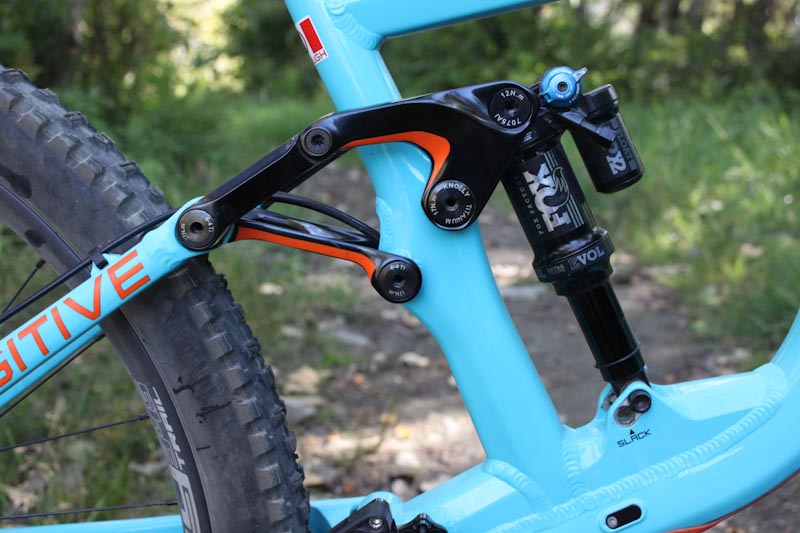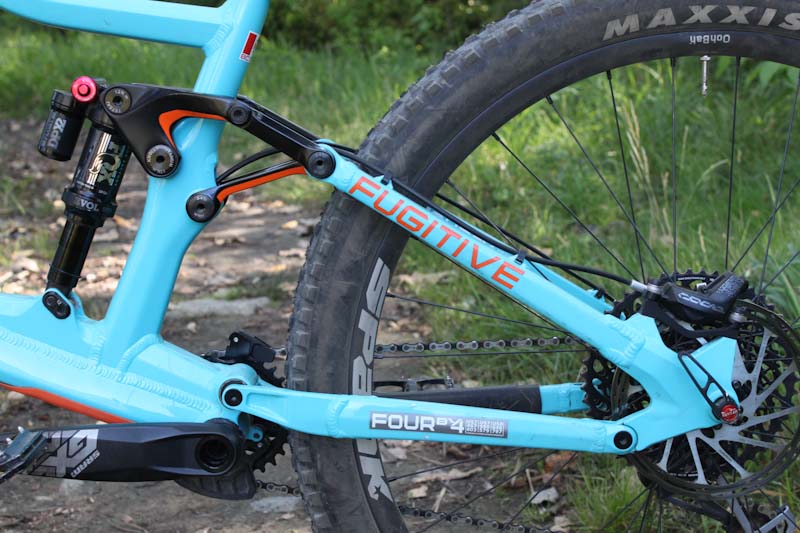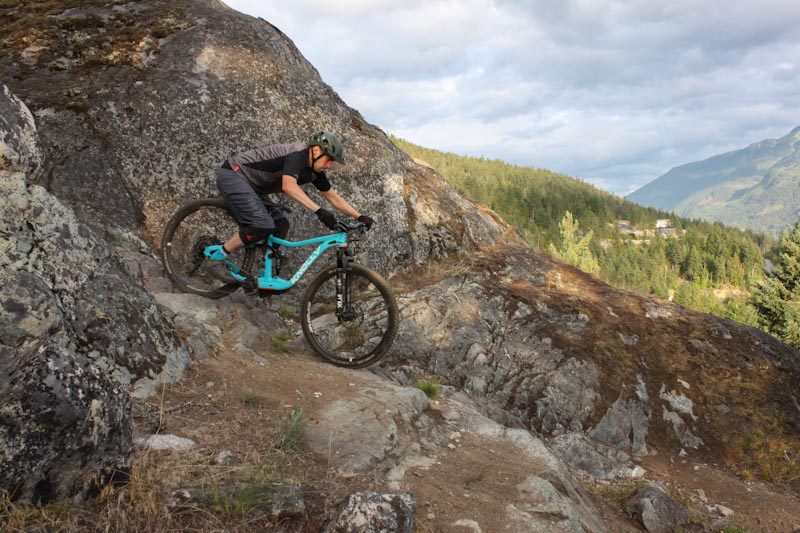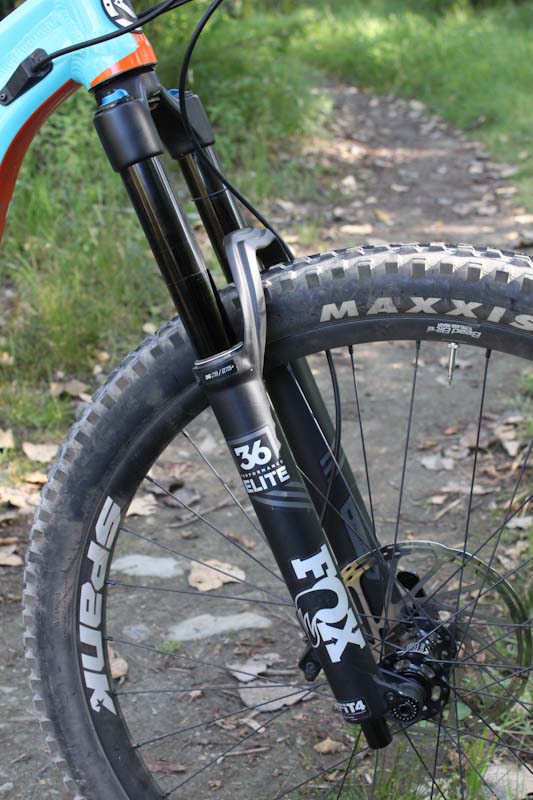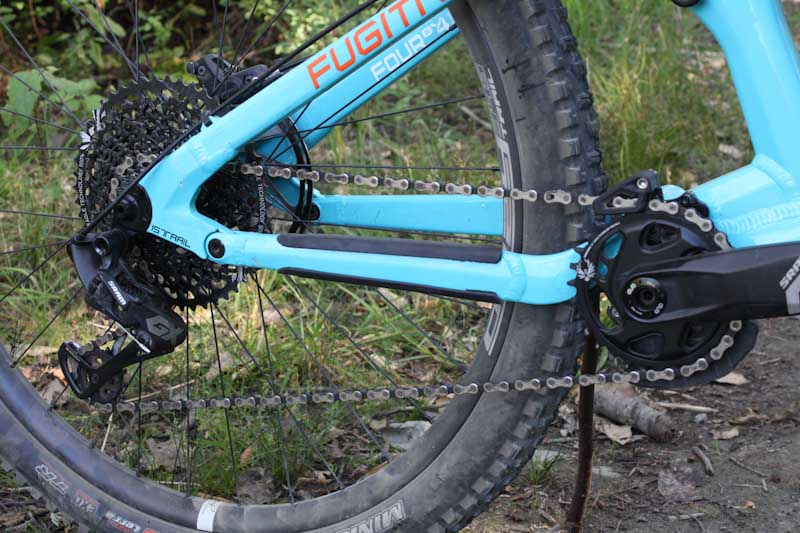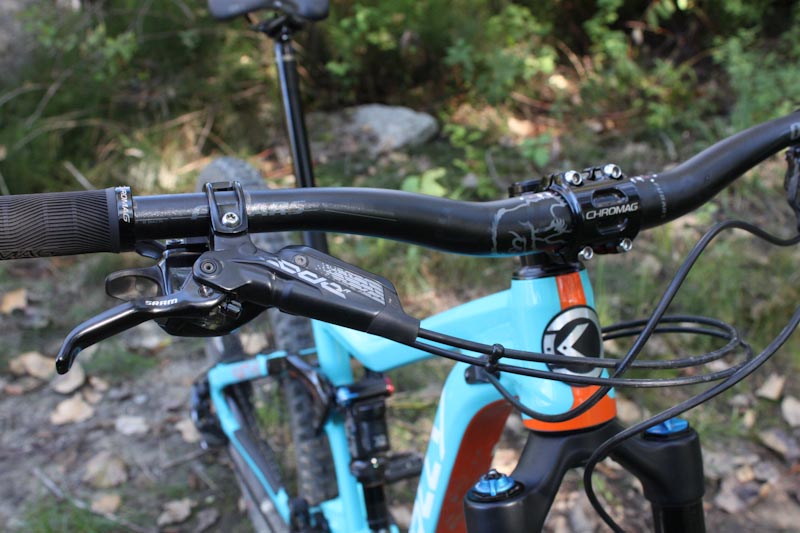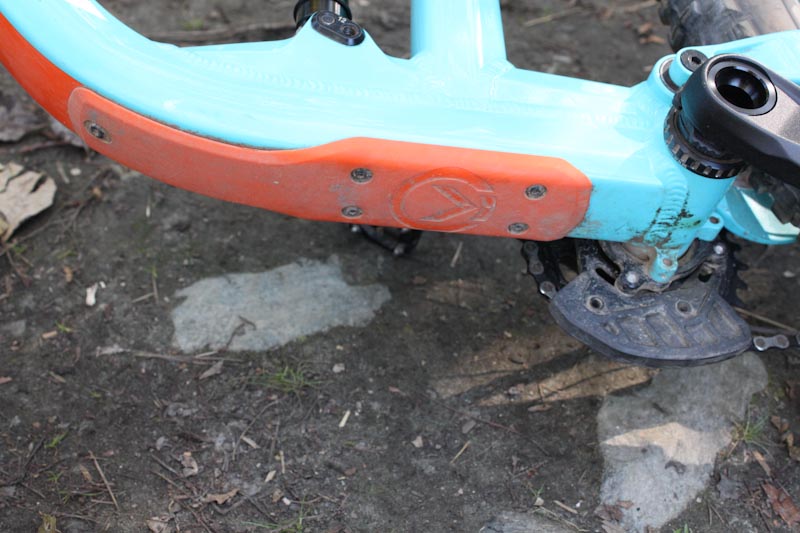This summer, I finally got to spend some quality time with one of Knolly’s bikes when I received a Fugitive LT for a long term review. This bike was designed to be Knolly’s most pedal-friendly and well-rounded trail bike, and it proved to offer excellent traction, a solid pedalling platform and a playful ride.
The 135mm Fugitive LT (with a 150mm fork) was an appropriate choice for my local trails, where climbing is mandatory but the descents can get rough. That said, this bike’s strong point is versatility, so it’s actually a solid performer on anything from epic backcountry loops to DH runs in the bike park.
Knolly Fugitive LT frame details:
 The Fugitive LT is made from hydroformed 6066 aluminum. The LT version of the Fugitive offers 135mm of rear travel, driven by Knolly’s Fourby4 linkage. This linkage is very tunable as its two links handle two different jobs; the lower link controls the wheel’s axle path, while the upper link handles the shock’s progression.
The Fugitive LT is made from hydroformed 6066 aluminum. The LT version of the Fugitive offers 135mm of rear travel, driven by Knolly’s Fourby4 linkage. This linkage is very tunable as its two links handle two different jobs; the lower link controls the wheel’s axle path, while the upper link handles the shock’s progression.
One major feature of the Fugitive LT is its 157 Trail rear end spacing. Knolly recently decided 157mm was the way to go, as it enabled them to make shorter rear ends with clearance for up to 2.6” tires. It also allows for stronger rear wheels (particularly ideal for 29ers). With a little re-shaping Knolly was able to keep their chain and seat stays no wider than some current Boost 148 bikes, and I had no issues with heel rub during my long-term test.
Another priority for Knolly is including full length straight seat masts in their frames. As dropper posts have become standard equipment, Knolly makes sure all sizes of their frames can run long travel posts. Small Fugitive LT’s can run 150-175mm, while mediums, larges and XL’s can run 175-200mm posts. They’ve also made sure the bottle mounts on the down tube will fit a water bottle under a reservoir shock.
The Fugitive LT has a threaded BB shell, ISCG05 mounts, and a removable E-Type mount for a front derailleur or top chain guide. Knolly’s frames also feature quality components like titanium pivot hardware, and a mix of dual-row angular contact bearings and long-lasting IGUS bushings.
The Fugitive LT’s cables are routed internally through the front triangle, then exit behind the rear linkage and run externally down the seatstays. Knolly uses large ports for easy maintenance and their plugs can accept 4mm, 5mm and Di2 housings. The plugs also hold the cable housings securely at both ends, which prevents the cables from rattling inside the frame. For those who go electronic, there is also a compartment in the frame for a Di2 battery.
The Fugitive LT offers Neutral and Slack shock mount positions, and the chart above shows the numbers for both modes. In stock form the Fugitive LT comes with a 150mm fork. Knolly says you can run up to a 160mm, but the geometry figures provided are based on a 150mm.
Ride Impressions: Geo and Fit
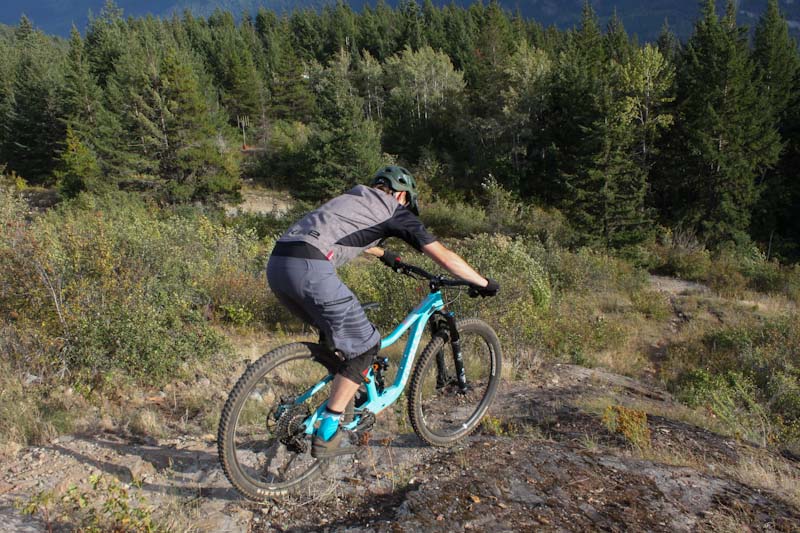 I’ve been riding the Fugitive LT for most of the summer, so I’ve had plenty of time to get familiar with its ride qualities. That said, my very first ride taught me something important about this bike: It may look like a heavy-duty rig, but the Fugitive LT offers a surprisingly nimble, playful ride. I started with the bike in its Neutral geo position, and its 66° head tube angle gave the bike snappy handling without feeling steep.
I’ve been riding the Fugitive LT for most of the summer, so I’ve had plenty of time to get familiar with its ride qualities. That said, my very first ride taught me something important about this bike: It may look like a heavy-duty rig, but the Fugitive LT offers a surprisingly nimble, playful ride. I started with the bike in its Neutral geo position, and its 66° head tube angle gave the bike snappy handling without feeling steep.
The short rear stays also help the bike maintain a nimble, whippy character that makes attacking tight corners fun. Maybe I’m just getting used to 29ers, but I found the Fugitive LT more agile and easier to toss around than several previous niners I’ve ridden.
The size medium I rode fit me very well. The 450mm reach leaves ample to move around on the bike, and puts the rider in a centered, well balanced position between the wheels. The Fugitive LT’s front end feels pretty low, and it could definitely be set up in a pretty aggressive position for climbing or racing (I kept a ¼” spacer under my stem).
A steep seat tube angle of 76° puts you up over the BB to ensure efficient pedalling, and the Neutral geo position keeps the BB riding high enough that I only tagged my pedals a few times in that setting. In the Neutral position, the Fugitive LT’s geometry strikes a fine balance that makes it a highly capable machine for tackling everything from technical climbs to steep, rough descents.
After a while I switched the shock into its slack position, and it definitely had a noticeable effect on how the Fugitive LT handled the trails. Descending, of course, was a bit more stable feeling with the BB dropped 10mm and the head tube slightly slacked out. The steering felt great at 65.25°, and even on the tightest switchbacks I find that angle just fine for climbing. That stubby rear end keeps the bike feeling quite agile in slack mode, so tight corners are still easy to whip around and picking up the front wheel is no problem.
Despite the fact that the seat and head tube angles only change by .75°, I found the Fugitive LT didn’t climb with the same gusto in Slack as it does in its Neutral position. On steeper uphill pitches, I was standing up and cranking more often in Slack mode than I did on my earlier rides. In Neutral mode only the steepest sections will get you out of the saddle, but in Slack I felt like my weight shifted backwards more than the angles would suggest. The BB does drop quite a bit, so you definitely have to watch your pedals in Slack mode.
Knolly’s founder Noel Buckley explained that the Fugitive LT’s Slack mode is intended to make the bike more stable for bike park laps or shuttle runs, and the Neutral position is much more trail-friendly. After riding in both I would agree the Neutral mode allows this bike’s versatility to shine, and the Slack mode is best suited for downhill days.
Suspension:
 The Fugitive LT was designed to be Knolly’s most pedal-efficient bike yet, but its rear end still does a great job of something else Knolly holds in high importance- providing traction. Their Fourby4 linkage is a highly active rear end that tracks well over rough stuff, but it also does a great job of resisting pedalling inputs.
The Fugitive LT was designed to be Knolly’s most pedal-efficient bike yet, but its rear end still does a great job of something else Knolly holds in high importance- providing traction. Their Fourby4 linkage is a highly active rear end that tracks well over rough stuff, but it also does a great job of resisting pedalling inputs.
When you start cranking hard, the Fugitive LT feels responsive to your efforts. While the rear end will move freely when a bump hits your wheel, it won’t let you wallow deep into the travel under pedalling forces alone. Again Knolly has hit a nice balance between providing efficient forward momentum and absorbing inputs from the trail below. Their Fourby4 linkage doesn’t need help from the rear shock to maintain pedalling efficiency, although the three-position shock my Fugitive LT came with adds versatility for varying terrain.
The Fourby4 linkage also provides a supportive enough ride that popping off jumps and bouncing through tight corners was a blast on the Fugitive LT. I was pleasantly surprised how lively the bike proved to be, and its poppy ride helps it feel agile and quite light on its feet.
Switching from Neutral to Slack modes has a minor effect on the shock rate (making the bike a bit more progressive in Slack) and I didn’t find a huge difference in shock rate between the two modes. Without adjusting air pressure, I was consistently hitting full travel on descents in either shock position.
The Fugitive LT’s Fox Float DPX2 EVOL rear shock has three modes. The Firm mode stiffens up the shock’s initial stroke quite a bit, and definitely boosts the bike’s pedalling efficiency. This setting is ideal for roads and smoother singletrack, but you will notice the bumps when climbing technical trails. The shock will still give way and use a fair bit of travel under wheel impacts, but you’ll feel the initial hit before it moves. Climbing traction remains very good in Firm mode until the trail gets really rough.
The shock’s Climb mode offers a softer ride going up singletrack, sucking up bumps much better than Firm mode. This mode opens up the rear shock more, but the linkage will keep you pedalling along at 50-55% travel until the rear wheel takes a hit. Even in Open mode the linkage keeps you pedalling at mid-travel, but traction on rougher trails gets even better.
With the shock in Open the rear wheel sticks to technical rocky or rooty climbs like glue, and with only a small sacrifice in all-out efficiency. On descents the Open mode allows the rear end to move freely, and the bike does a fine job of finding traction in rough patches and taking the edge off bigger, sharper hits. The Fugitive LT is one of those bikes that performs well in any mode, so each rider will determine their favorite option for the trail at hand.
Components:
The Fugitive LT model I rode is called the Dawn Patrol. There are higher-spec Dawn Patrol Plus and Supreme Leader builds available, but the ‘base model’ Dawn Patrol is hardly an entry-level bike.
Knolly buyers can opt for either Rockshox or Fox suspension packages, and my bike was set up with Fox’s 36 Performance Elite 150mm fork and a Float DPX2 EVOL rear shock. The fork performed great, offering plush action on big hits and a sensitive, supple ride on less bumpy singletrack. This model offers high and low speed compression and rebound adjustments so any rider should be able to dial it in to their liking. With the DPX2 rear shock’s Firm/Climb/Open modes, the bike can easily be adjusted for any terrain. While pedalling stiffens up noticeably, I find the DPX2’s do a good job of opening up when the wheel takes an impact in Climb or Firm modes.
SRAM’s GX Eagle drivetrain components performed well throughout my test, with barely any adjustment required all summer. The GX components hit that ‘good enough for most’ point where shifting is crisp, quick and very reliable. The 12 speed cassette was paired to a 30t front ring, giving me low enough gearing to clamber up any climb.
My Fugitive LT had a 150mm Rockshox Reverb dropper post, which did get sticky on me a few times, requiring a good butt-slap to budge it down. I have ridden Rockshox’s 2020 Reverb post, and they definitely fixed this issue as the newer models drop with very little effort.
The Spank Oozy 345 wheelset took more than a few hard hits on the front and rear rims, but held up great. The front spins like its brand new, and the rear is maybe 2mm’s out of true with one barely noticeable dent in the sidewall. These wheels provide a pretty stiff ride, which was great for hard cornering and plowing through rocky chutes.
Knolly went for tried-and-true Maxxis Minion DHF/DHR 3C Maxx Terra EXO TR tires, which are favorites of mine for their excellent grip in all conditions. The 2.3” stock treads aren’t too heavy and roll pretty well, so they’re a good fit for a do-it-all trail bike.
The SRAM Code R brakes on 200/180mm rotors offered a ton of grabbing power, and never needed a bleed to keep them feeling consistent and strong. I was stoked to see Chromag’s 800mm Fubar handlebars, Basis grips, 50mm Hifi stem and Lynx DT saddle on the Fugitive LT. It’s nice to see Knolly teaming up with a fellow Canadian brand that has a great reputation for building awesome components.
For a little protection, the frame has a large guard on the down tube and OneUp Components’ Bash Guide comes stock on the Dawn Patrol and Supreme Leader build kits. It’s a nice addition for a bike designed for technical terrain, and will probably come in handy if you ride in the low-slung Slack position!
The complete medium framed Fugitive LT weighs 33.82lbs with pedals, which is not bad for a highly capable 29er that’s built ‘BC Tough’. The Dawn Patrol model I rode sells for $5129, and it comes in S/M/L/XL frame sizes. Color choices are black, raw/orange and blue/orange.







